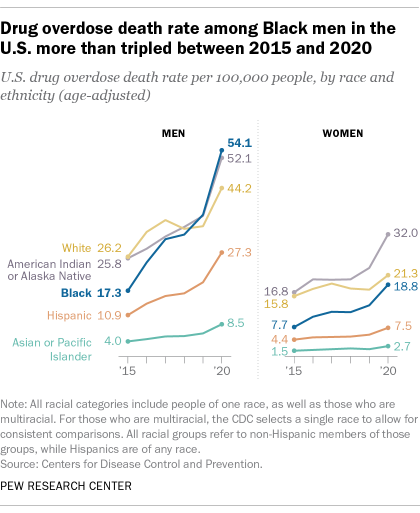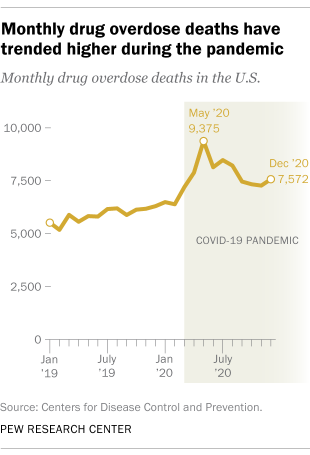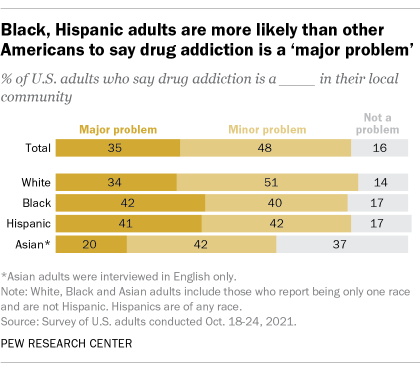Nearly 92,000 Americans died of drug overdoses in 2020, marking a 30% increase from the year before, a 75% increase over five years and by far the highest annual total on record, according to the Centers for Disease Control and Prevention (CDC). Preliminary figures suggest that the 2021 death toll from overdoses may be even higher.
While overdose death rates have increased in every major demographic group in recent years, no group has seen a bigger increase than Black men. As a result, Black men have overtaken White men and are now on par with American Indian or Alaska Native men as the demographic groups most likely to die from overdoses.
This Pew Research Center analysis examines how drug overdose death rates in the United States differ by gender, race and ethnicity. It is based on data from the Centers for Disease Control and Prevention (CDC).
Drug overdose death rates for all racial and ethnic groups come from the CDC WONDER database – specifically, the database showing underlying causes of death by bridged-race categories for the years 1999 through 2020. Bridged-race categories include people of one race, as well as those who are multiracial. For those who are multiracial, the CDC selects a single race to allow for consistent comparisons. Read more about bridged-race categories here. Pew Research Center relied on the CDC’s bridged-race database instead of the single-race database to examine how drug overdose death rates changed over the 2015-2020 period; the single-race database covers only the 2018-2020 period.
In this analysis, all racial groups refer to non-Hispanic members of those groups, while Hispanics are of any race. All death rates are adjusted to account for age differences between U.S. demographic groups.
The public opinion data cited here comes from a Pew Research Center survey conducted in October 2021 among 9,676 U.S. adults. Everyone who took part is a member of the Center’s American Trends Panel (ATP), an online survey panel that is recruited through national, random sampling of residential addresses. This way nearly all U.S. adults have a chance of selection. The survey is weighted to be representative of the U.S. adult population by gender, race, ethnicity, partisan affiliation, education and other categories. You can read more about the ATP’s methodology and the methodology of the October 2021 survey.
There were 54.1 fatal drug overdoses for every 100,000 Black men in the United States in 2020. That was similar to the rate among American Indian or Alaska Native men (52.1 deaths per 100,000 people) and well above the rates among White men (44.2 per 100,000) and Hispanic men (27.3 per 100,000). The overdose death rate among men was lowest among Asians or Pacific Islanders (8.5 per 100,000).
As recently as 2015, Black men were considerably less likely than both White men and American Indian or Alaska Native men to die from drug overdoses. Since then, the death rate among Black men has more than tripled – rising 213% – while rates among men in every other major racial or ethnic group have increased at a slower pace. The death rate among White men, for example, rose 69% between 2015 and 2020.
As has long been the case, women in the U.S. are less likely than men to die from drug overdoses. But death rates have risen sharply among women, too, especially Black women. The overdose fatality rate among Black women rose 144% between 2015 and 2020, far outpacing the percentage increases among women in every other racial or ethnic group during the same period.
Despite the steep rise in the overdose death rate among Black women, American Indian or Alaska Native women continued to have the highest such rate in 2020, as has been the case for most of the past two decades. There were 32 overdose deaths for every 100,000 American Indian or Alaska Native women in 2020, compared with 21.3 deaths for every 100,000 White women and 18.8 deaths for every 100,000 Black women. Fatality rates were much lower among Hispanic women (7.5 per 100,000) and Asian or Pacific Islander women (2.7 per 100,000).
The racial groups in this analysis include people of one race, as well as those who are multiracial. All death rates are adjusted to account for age differences between U.S. demographic groups. For more information about the methodology, read the “How we did this” box.
Overdose deaths have risen sharply during the pandemic
While overdose deaths in the U.S. were on the rise long before the outbreak of COVID-19 in March 2020, such fatalities have accelerated during the pandemic, the CDC has noted.
Nationwide, the monthly number of drug overdose deaths had never exceeded 6,500 before March 2020. Between March and December 2020, there were more than 7,100 such deaths each month, including nearly 9,400 in May 2020 alone.
Experts have pointed to several possible reasons for the increase in overdose deaths during the outbreak, including less access to treatment and a rise in mental health problems associated with the pandemic.
The opioid epidemic has also played an important role in the soaring number of overdose deaths, both during the pandemic and in the years leading up to it. Three-quarters of all fatal overdoses in 2020 involved opioids, with more than six-in-ten involving synthetic opioids – a category that includes fentanyl, a potent pain relief drug that is commonly manufactured and sold illegally. The overdose fatality rate involving synthetic opioids rose nearly sixfold between 2015 and 2020, from 3.1 to 17.8 deaths per 100,000 people. Earlier waves of opioid overdose deaths in the U.S. involved heroin and prescription opioids, respectively.
Death rates have also risen sharply in recent years for overdoses involving stimulants such as cocaine and methamphetamine. The fatality rate for overdoses involving cocaine nearly tripled between 2015 and 2020, from 2.1 to 6.0 deaths per 100,000 people. The fatality rate for overdoses involving methamphetamine and other psychostimulants more than quadrupled between 2015 and 2020, from 1.8 to 7.5 deaths per 100,000 people. These deaths have disproportionately affected racial and ethnic minority groups.
Even as overdose deaths have soared, public concern about drug addiction in the U.S. has ticked down, according to Pew Research Center surveys. In early 2018, 42% of U.S. adults said drug addiction was a major problem in their community, but that percentage declined to 35% in October 2021. Around four-in-ten Black (42%) and Hispanic adults (41%) said in the 2021 survey that drug addiction was a major problem in their community, compared with smaller shares of White (34%) and Asian adults (20%).
CORRECTION (Jan. 21, 2022): An earlier version of this analysis, including a chart headline, incorrectly said that Black men were the demographic group most likely to die from drug overdoses in 2020. The fatality rate among Black men in 2020 was similar to the rate among American Indian or Alaska Native men but did not statistically exceed it.



